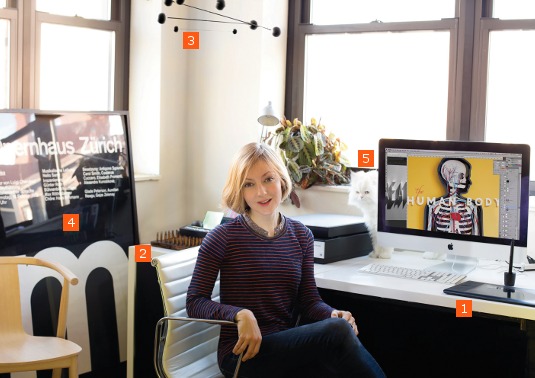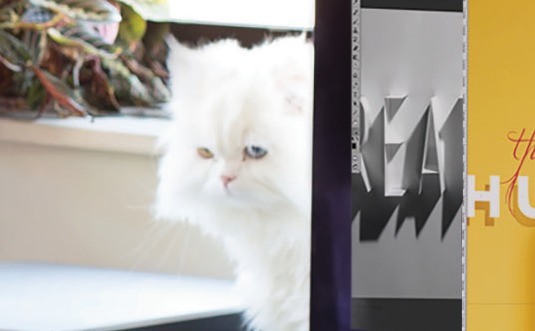This inspiring workspace features an amazing transforming desk
Kelli Anderson takes us on a tour of her home studio featuring a custom standing desk and more.

I've noticed that the tools I use end up shaping all of my work. As a defence, I try to beat this game by preemptively shaping my tools, like my desk (1). My desk is built to accommodate my idiosyncratic work habits. It transforms (via a linear actuator) into a standing desk for the working hours, but contracts down into a solid shape (like a normal piece of furniture) when not in use. In my one-room apartment/studio, this working and not-working positioning differentiation serves an important psychological purpose. Even though my desk is always in sight, it changes my relationship to the object, which helps me to disengage from work when it's lowered.

The inside cabinets are filled with wide, shallow plexiglass drawers. These facilitate my need to visually organise projects into little piles. There's a built-in tool chest organised by utility, with drawers for 'adhering things to other things', 'severing things', and 'measuring things'. I'm trying to make a space that prioritises my actions, so there is as little psychic friction between me and getting the work done as possible.
I wanted to designate an area on top of my desk for any physical aids to memory. This gridded pegboard, that was originally used for drying spools of thread (2), houses material scraps of inspiration including business cards, print samples and plexiglass shards.
Looming overhead is a solar-system-esque mobile (3). I made it myself by gorilla-glueing wooden spheres to carbon fiber rods. The large poster (4) by Josef Müller-Brockmann serves to always remind me that simpler is often better.

There's usually at least one cat lurking in front of or behind my computer monitor (5), typically about to waylay some unfortunate insect near the window.
Words: Kelli Anderson
Kelli Anderson is an artist and designer based in Brooklyn, making images and seeking alternate possibilities for everyday things. This article originally appeared in net magazine issue 253.
Daily design news, reviews, how-tos and more, as picked by the editors.

The Creative Bloq team is made up of a group of art and design enthusiasts, and has changed and evolved since Creative Bloq began back in 2012. The current website team consists of eight full-time members of staff: Editor Georgia Coggan, Deputy Editor Rosie Hilder, Ecommerce Editor Beren Neale, Senior News Editor Daniel Piper, Editor, Digital Art and 3D Ian Dean, Tech Reviews Editor Erlingur Einarsson, Ecommerce Writer Beth Nicholls and Staff Writer Natalie Fear, as well as a roster of freelancers from around the world. The ImagineFX magazine team also pitch in, ensuring that content from leading digital art publication ImagineFX is represented on Creative Bloq.
